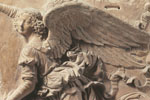17 September 2009
Art and grammar
I noticed something recently while writing music at the piano. The section I was working on contained two independent lines separated between the hands, but at one point the harmonies generated became noticeably thin and the two lines were no longer distinct. It was obvious that the problem was a few successive parallel octaves (parallel perfect intervals diminish the sense of separate voices) so I reworked the section to eliminate the error but keep the intended mood. I recognized the error because of how it sounded, and even understood how to fix it by reworking the melodies and listening, but understanding the process involved a working knowledge of the grammar of music.
The High was recently showing Monet's Waterlillies. Currently, they're showing works of Leonardo Da Vinci. For major shows, they will display a large-scale poster covering the front of their main building and facing Peachtree Street. The Monet was a section of a Waterlillies painting with an overall right-pointing triangular layout (c.f. the Classical design style that often uses the more stable hypotenuse-base triangle). The Da Vinci poster consists of a section of a terracotta relief sculpture that contains a reclining angel (clipped section below).

The figure suggests a syncopation of geometric shapes fitted elegantly and embellished with slight, Renaissance curves. You can immediately see the artist's thoughts as he blocked out the design.
Both instances show how an understanding of the grammar of the arts helps the viewer both to understand the mechanics of communication and to recognize the cause of flawed communication.
- Music from the Sonic Generator concert, 6 May 2015 posted by sstrader on 7 May 2015 at 11:01:42 PM
- The strangely enduring power of kitsch posted by sstrader on 21 December 2014 at 4:34:46 PM
- Nowhere Men phantom issues posted by sstrader on 22 April 2014 at 11:55:50 PM
- Where was I? posted by sstrader on 22 February 2014 at 11:54:34 AM
- New comic books discovered in Denver in October posted by sstrader on 7 December 2013 at 11:06:53 AM Other entries categorized in Language & Literature:
- The city posted by sstrader on 6 March 2016 at 9:43:27 PM
- The children of Infinite Jest posted by sstrader on 23 August 2015 at 3:48:24 PM
- Posthuman dystopia posted by sstrader on 22 March 2015 at 10:21:25 AM
- Poetry and apocalypse posted by sstrader on 22 November 2014 at 10:41:33 AM
- Roman Jakobson's functions of language posted by sstrader on 5 October 2014 at 10:36:23 AM Other entries categorized in Music:
- The vinyl and the concert posted by sstrader on 21 May 2016 at 1:59:26 PM
- Rod McKuen posted by sstrader on 22 March 2016 at 8:58:35 PM
- More political transcriptions posted by sstrader on 20 March 2016 at 10:19:06 AM
- Notes on We Don't Care About Music Anyway posted by sstrader on 7 June 2015 at 1:06:34 PM
- Ives Concord Sonata posted by sstrader on 13 February 2015 at 5:13:17 PM